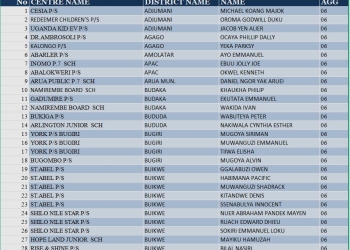
KAMPALA — Uganda’s central bank announced Wednesday it will maintain its benchmark interest rate at 9.75%, citing increased risks in the global economy despite domestic inflation remaining near its target.
Bank of Uganda Governor Michael Atingi-Ego said in a statement following a Monetary Policy Committee (MPC) meeting on Tuesday that the decision reflects growing uncertainty in the international economic landscape.
While Uganda’s headline inflation edged up to 3.5% and 3.9% in April from 3.4% and 3.6% in March, primarily due to higher food prices, the underlying core inflation remains below the bank’s medium-term goal of 5%, Atingi-Ego noted.
The governor attributed the current inflation picture to a combination of factors, including a resilient domestic economy, a stable exchange rate, and lower global prices for food and energy. He said the near-term inflation outlook aligns with February projections, partly due to exchange rate stability. However, the medium-term forecast anticipates a slightly higher inflation range of 4.5% to 5.5% for the 2025-26 fiscal year, with expectations of a gradual return to the 5% target.
Atingi-Ego pointed to potential upside risks to inflation, including adverse weather impacting agriculture, escalating geopolitical tensions disrupting supply chains, stronger global demand leading to higher import costs, and a weakening exchange rate due to global economic and financial market volatility.
Downside risks, he added, include lower global commodity prices, weaker-than-expected domestic demand, slower global growth easing international price pressures, improved supply chains, and stronger growth in major economies reducing external inflation.
Regarding economic activity, Atingi-Ego said the Ugandan economy has shown resilience despite global challenges such as renewed geopolitical tensions and evolving trade policies. He noted that the composite index of economic activity for the quarter ending in March 2025 indicates continued growth, particularly in the services and construction sectors. However, agricultural output has slowed due to unfavorable weather, while household spending has been supported by increased real incomes.
The central bank’s economic growth forecast for the current fiscal year remains between 6.0% and 7.0%, although risks lean to the downside. This outlook is supported by anticipated improvements in global growth, increased investment in the extractive industries, and ongoing government initiatives.
Atingi-Ego also highlighted downside risks to economic growth, including persistent adverse weather affecting agriculture, slower global growth and trade restrictions impacting exports, geopolitical tensions disrupting supply chains, elevated global inflation leading to policy uncertainty, and higher domestic borrowing costs potentially hindering private sector investment.
On the positive side, faster resolution of global uncertainties, positive trade developments, stronger tourism, pro-growth policies in major economies, and increased investment in the oil and gas sector could boost economic activity.
Dr. Atingi-Ego emphasized that the MPC believes the current monetary policy stance is appropriate to keep inflation around its target in the medium term. As a result, the central bank will maintain the CBR at 9.75%, with the lending rate at 11.75% and the deposit rate at 7.75%. The discount rate will remain at 12.75%, and the bank rate at 13.75%.
The Bank of Uganda, under Atingi-Ego’s guidance, said it will continue to closely monitor inflation and economic growth risks and is prepared to take necessary actions to maintain price stability and support sustainable economic development. Future adjustments to the key interest rate will be guided by incoming economic data and ongoing assessments of the economic outlook.

















